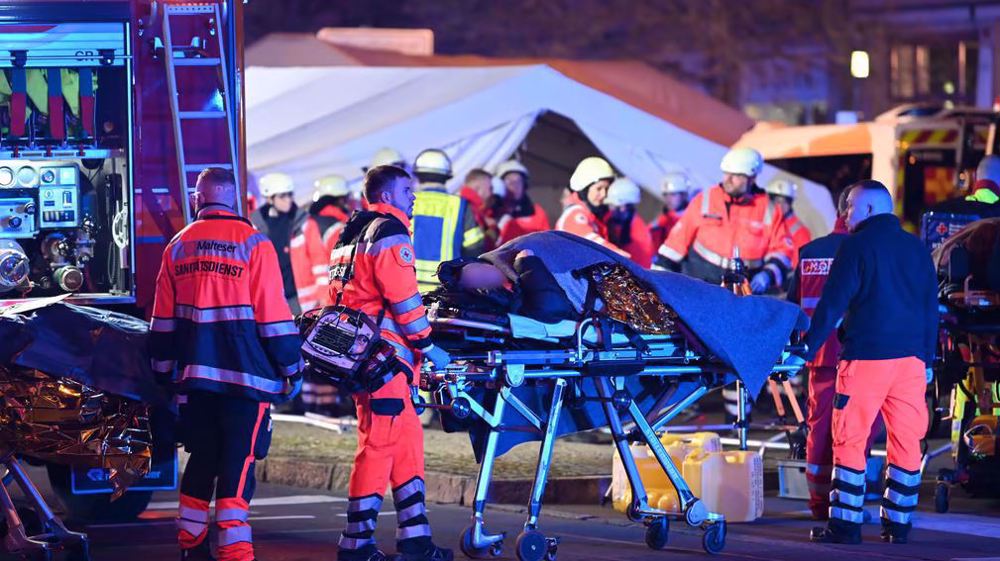Yemeni missile beat US missile defense systems in Saudi Arabia: Research
Despite Saudi Arabia’s constant denials, new evidence shows that a Yemeni ballistic missile fired last month did hit the Riyadh airport a short while ago, according to a new report.
The Yemeni army, backed by Houthi Ansarullah fighters, claimed on November 5, that the Borkan-2 (Volcano-2) medium-range ballistic missile had landed on King Khalid International Airport, located 35 kilometers north of the Saudi capital Riyadh.
Saudi officials rushed to deny the news, putting on display parts of the actual missile to back up their own claim that the missile had been shot down by American Patriot missile system, which is designed to counter missile threats.
New evidence, however, has further revealed the bitter truth that the Riyadh regime has been so adamantly trying to hide: Yemenis were indeed able to fire a ballistic missile from over 600 miles (more than 965 km) and successfully land it on a target deep inside the kingdom.
In a new report published Monday, The New York Times provided satellite data and visual evidence that proved the success of the Yemeni missile forces, or to put it more clearly, the failure of the US military’s supposedly cutting-edge missile defense system in deterring a missile of the Scud family, which have been around since the 1950s.
Citing evidence analyzed by a team of missile experts, the Times reported that “the missile’s warhead flew unimpeded over Saudi defenses” and “detonated so close to the domestic terminal that customers jumped out of their seats.”
The past records of US missile systems
The first rebuttal of the Saudi claims of shooting down the missile offered in the report is a simple fact: American missile defense systems have always had a hard time targeting missiles of the Scud family.
“During the first (Persian) Gulf War, the United States claimed a near-perfect record in shooting down Iraqi variants of the Scud. Subsequent analyses found that nearly all the interceptions had failed,” the report reads.
The missile debris
Social media footage of debris scattered around in streets shows that either the Saudi military forces either targeted the missile’s harmless body or had missed that part as well.
The missile parts started to rain on downtown Riyadh at the same time that Saudis fired off missile defenses.
After being collected, the debris was put on display on state TV as evidence that the missile was successfully neutered mid-air. The footage contained a major giveaway: the war head was missing.

Ballistic would separate into two parts mid-flight to reduce the flight stress and increase the chances of evading defensive measures.
“The tube, which propels the missile for most of its trajectory, falls away. The warhead, smaller and harder to hit, continues toward the target,” the experts said, arguing that since the debris displayed in Riyadh were only consisted of the rear tube it could be safely assumed that the warhead had continued toward its target.
The location of the explosion
While the debris were falling down somewhere in Riyadh, and explosion was heard at the airport 12 miles away, suggesting that the warhead had successfully delivered the explosives to its target.
“There was an explosion at the airport,” a man said in a video taken moments after the blast.

Another video, taken from the tarmac, shows the emergency vehicles at the end of the runway while beyond them is a plume of smoke is clearly visible, resembling a possible point of impact.
Also, Saudi officials claimed that some of the debris was gathered from the airport, which is unlikely unless we accept that some part had somehow managed to keep course and fly for another 12 miles on their own.
The impact
Meanwhile, analysts were able to locate the Patriot batteries that tried to target the missile and were positive that the warhead had flown way beyond them before impact.
Judging by “the emergency response and a plume of smoke” seen at the airport, the experts further argue that the Yemeni missile had defied the defense systems.

“A photo of the plume taken from a different location on the tarmac appears consistent with plumes produced by similar missiles, suggesting the explosion was not an errant piece of debris or an unrelated incident,” the report noted.
Using satellite imagery and identifying buildings seen in the video footage from the explosion, the experts were also able to locate the precise location of the plume, near the runway 33R and the airport’s domestic terminal.
While available imagery taken immediately before and after the blast is not detailed enough to show an impact crater, it still shows the “ground damage from the emergency vehicles” at the blast site.
US systems’ performance ‘shocking’
Laura Grego, a missile expert at the Union of Concerned Scientists, told the Times that given the Saudi military’s firing of five missiles to intercept the Borkan, the fact that tit could still hit its target was “shocking.”
"You shoot five times at this missile and they all miss? That's shocking,” she said. “That's shocking because this system is supposed to work.”
The alleged downing were even touted by US President Donald Trump, who boasted, "our system knocked the missile out of the air."
Jeffrey Lewis, the analyst who led the research into the Yemeni missile, said Saudi officials denying the impact were either lying or had received the wrong information.
“Governments lie about the effectiveness of these systems. Or they’re misinformed,” said Lewis. “And that should worry the hell out of us.”
Yemeni army strikes Israeli military sites with drones
‘Clock ticking’: UNRWA slams unjustifiable killing of children in Gaza
BP to be sued in Britain for supplying oil to Israel
VIDEO | Press TV's news headlines
Israeli strikes on north Gaza hospital ‘extremely dangerous, terrifying’: Director
VIDEO | Yemen targets Tel Aviv with Palestine 2 missiles
Pezeshkian: Iran resolved to complete North-South Transport Corridor
VIDEO | Iran-Syria: For Resistance










 This makes it easy to access the Press TV website
This makes it easy to access the Press TV website